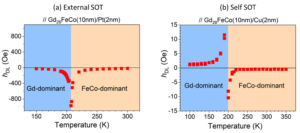 On Thursday, March 30th 2023, we have the pleasure to welcome in SPINTEC Sebastien Petit Wattelot from Institut Jean Lamour (Lorraine Univ.). He will give us a seminar at 16:00, entitled :
On Thursday, March 30th 2023, we have the pleasure to welcome in SPINTEC Sebastien Petit Wattelot from Institut Jean Lamour (Lorraine Univ.). He will give us a seminar at 16:00, entitled :
Spin currents generation and (Self)Torque in GdFeCo ferrimagnet
Place : SPINTEC Seminar, CEA Building 10.05 auditorium 445 (access needs badge (*))
visioconf link : https://univ-grenoble-alpes-fr.zoom.us/j/3241920232
Abstract : Spin currents and spin-torques (ST) generated through spin-orbit coupling (SOC) has been widely studied in ferromagnet/heavy metal bilayers [1,2]. The heavy metal is presented as an essential element of the structure since it generates a pure spin current through the Spin Hall Effect (SHE) which induces ST on the neighboring magnetic layer. Similarly, it is generally accepted that in magnetic materials, the spin polarization of the generated spin current is aligned with the direction of the magnetization due to the exchange interaction. The generation of such spin current is referred to as the Spin Anomalous Hall Effect (SAHE) [3]. However, theoretical works [4,5] have shown that the latter description is incomplete for magnetic materials with large spin-orbit coupling. In this case, the spin polarization can be preserved from alignment with the magnetization. The total spin current is therefore the sum of SAHE-like and SHE-like spin currents [3-5]
In this talk, we present a study on the ferrimagnet: GdFeCo, which combine strong SOC through the 5d conduction bands of Gd, and low magnetization. We show that GdFeCo is effectively the source of spin currents with the SAHE-like and SHE-like symmetries using spin-torque Ferromagnetic measurements [6]. We also show that the latter symmetry can induce a torque on the ferrimagnet magnetization, which we called self-torque [7]. To quantify the self-torque, we performed harmonic Hall voltage measurements on GdFeCo interfaced with a light metal. We first focus on the temperature dependence of the effective fields associated with the self-torque. We show that the effective fields are magnified near the magnetic compensation temperature TCM and reverse sign on both sides of it (see Fig. 1) [6,7]. We show that self-torque exhibits different characteristics compared to the external Spin-Orbit Torque. Our results pave the way for new architectures to exploit self-torque generated in single magnetic layer.

Fig. 1: Temperature dependence of the damping-like effective field hDL for GdFeCo interfaced with a heavy metal (a) and a light metal (b).
[1] A. Manchon et al., Reviews of Modern Physics, vol. 91, no 3, p. 035004, (2019).
[2] Q. Shao et al., IEEE Transactions on Magnetics (2021).
[3] T. Taniguchi et al., Physical Review Applied, vol. 3, no 4, p. 044001, (2015).
[4] V. P. Amin, et al., Physical Review B, vol. 99, no 22, p. 220405, (2019).
[5] K-W. Kim, et al., Physical Review Letters, vol. 125, no 20, p. 207205, (2020).
[6] H. Damas, et al. Phys. Status Solidi RRL, 2200035, 2022.
[7] D. Céspedes‐Berrocal et al., Advanced Materials 33.12: 2007047, 2021.
Authors : Héloïse DAMAS1, Sébastien PETIT-WATELOT1, Alberto ANADON1, David CESPEDES-BERROCAL1,2, Davide MACCARIELLO3, Junior ALEGRE-SAENZ1,2, Jean-Loïs BELLO1, Aldo ARRIOLA-CORDOVA1,2, Michel HEHN1, Vincent CROS3, Albert FERT3, and Juan-Carlos ROJAS-SANCHEZ1
- Université de Lorraine, CNRS, Institute Jean Lamour, F-54000 Nancy, France
- Universidad Nacional de Ingeniería, Rímac 15333, Peru
- Unité Mixte de Physique, CNRS, Thales, Université Paris-Saclay, 91767 Palaiseau, France
(*) Persons who do not have a CEA badge must request an entry authorization sufficiently in advance, before March 23th at admin.spintec@cea.fr




